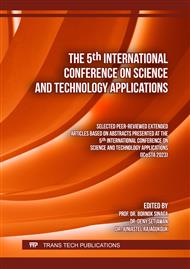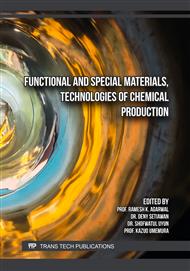[1]
M.Y. Khorasani, H. Langari, S. B.T. Sany, M. Rezayi, and A. Sahebkar, The role of curcumin and its derivatives in sensory applications, Mater. Sci. Eng. C 103, May 109792, pp.1-10, (2019).
DOI: 10.1016/j.msec.2019.109792
Google Scholar
[2]
T. Devasena, N. Balasubramanian, N. Muninathan, K. Baskaran, and S. T. John, Curcumin Is an Iconic Ligand for Detecting Environmental Pollutants, Bioinorg. Chem. Appl. 2022, pp.1-12, (2022).
DOI: 10.1155/2022/9248988
Google Scholar
[3]
N. T. D. Dey and V. R. Shanker, Validation of copper decorated Graphene oxide material for assaying Curcumin, Front. Nanosci. Nanotechnol. 7, 1, p.1–11, (2021)
DOI: 10.15761/fnn.1000194
Google Scholar
[4]
Y. Pu, Y. Wu, Z. Yu, L. Lu, and X. Wang, 2021 Simultaneous determination of Cd2+ and Pb2+ by an electrochemical sensor based on Fe3O4/Bi2O3/C3N4 nanocomposites, Talanta Open 3, November 2020, p.0–6, (2021).
DOI: 10.1016/j.talo.2020.100024
Google Scholar
[5]
R. Golbedaghi, S. Jafari, and M. Reza,Determination of cadmium ( II ) ion by atomic absorption spectrometry after cloud point extraction, J. Iran. Chem., 9, p.251–256, (2012).
DOI: 10.1007/s13738-011-0018-7
Google Scholar
[6]
Z. Li and L. Zhou, Atomic Fluorescence Spectrometry after Ultrasound-Assisted Sample Preparation, J. Braz. Chem. Soc., 19, 7, p.1347–1354, (2008).
DOI: 10.1590/s0103-50532008000700017
Google Scholar
[7]
J. E.O. Sullivan, R. J. Watson, and E. C. V. Butler, Talanta An ICP-MS procedure to determine Cd , Co , Cu , Ni , Pb and Zn in oceanic waters using in-line fl ow-injection with solid-phase extraction for preconcentration, Talanta, 115, p.999–1010, (2013).
DOI: 10.1016/j.talanta.2013.06.054
Google Scholar
[8]
C. Ariño, N. Serrano, J. M. Díaz-cruz, and M. Esteban M, Voltammetric determination of metals beyond mercury electrodes: A Review, Anal. Chim. Acta, 990, Octobe 2017, p.11–53, (2017).
DOI: 10.1016/j.aca.2017.07.069
Google Scholar
[9]
L.A. Machhindra and Y. K. Yen, A Highly Sensitive Electrochemical Sensor for Cd2+ Detection Based on Prussian Blue-PEDOT-Loaded Laser-Scribed Graphene-Modified Glassy Carbon Electrode, Chemosensors, 10, 6, pp.1-13, (2022).
DOI: 10.3390/chemosensors10060209
Google Scholar
[10]
B. Mulyati and R. S. Panjaitan, Development of Differential Pulse Anodic Stripping Voltammetry Technique for cadmium(II) Detection and Its Application in Water Spinach, Indones. J. Chem. Res., 9, 2, p.129–136, (2021).
DOI: 10.30598//ijcr.2020.9-riz
Google Scholar
[11]
H. Dai, N. Wang, D. Wang, H. Ma, and M. Lin, An electrochemical sensor based on phytic acid functionalized polypyrrole/graphene oxide nanocomposites for simultaneous determination of Cd(II) and Pb(II), Chem. Eng. J., 299, p.150–155, (2016).
DOI: 10.1016/j.cej.2016.04.083
Google Scholar
[12]
K. Krishna Kumar, M. Devendiran, R.A. Kalaivani, and S. Narayanan, Polycurcumin nanospheres modified electrode for nanoscale detection of mercury ions in seawater, Chem. Phys. Lett., 781, May 2020, p.138974, (2021).
DOI: 10.1016/j.cplett.2021.138974
Google Scholar
[13]
A. Mejri, A. Mars, H. Elfil, and A. H. Hamzaoui, Graphene nanosheets modified with curcumin-decorated manganese dioxide for ultrasensitive potentiometric sensing of mercury(II), fluoride and cyanide, Microchim. Acta, 185, 12, p.3–10, (2018).
DOI: 10.1007/s00604-018-3064-3
Google Scholar
[14]
B. Devadas, M. Rajkumar, and S. M. Chen, Electropolymerization of curcumin on glassy carbon electrode and its electrocatalytic application for the voltammetric determination of epinephrine and p-acetoaminophenol, Colloids Surfaces B Biointerfaces, 116, p.674–680, (2014).
DOI: 10.1016/j.colsurfb.2013.11.002
Google Scholar
[15]
N. Elgrishi, K. J. Rountree, B. D. McCarthy, E. S. Rountree, T. T. Eisenhart, and J. L. Dempsey, A practical beginner's guide to cyclic voltammetry, J. Chem. Educ., 95, 2, p.197–206, (2018).
DOI: 10.1021/acs.jchemed.7b00361
Google Scholar
[16]
S. Marwati, D. Siswanta, W. Trisunaryanti and I. S. Y. Louise, 2020 Polyeugenol-modified graphite electrode for determination of hydroquinone in cosmetic, J. Phys. Conf. Ser. 1485, 1, p.0–7, (2020).
DOI: 10.1088/1742-6596/1485/1/012034
Google Scholar
[17]
A. Gubendran, M. Amutha, P. Dhanasekaran, A. Imayatharasi, and M. Vijayalakshmi, Synthesis, characterization and pharmaceutical applications of Curcumin metal complex, J. Pharm. Biol. Sci., 11, 6, p.80–84, (2016).
Google Scholar



